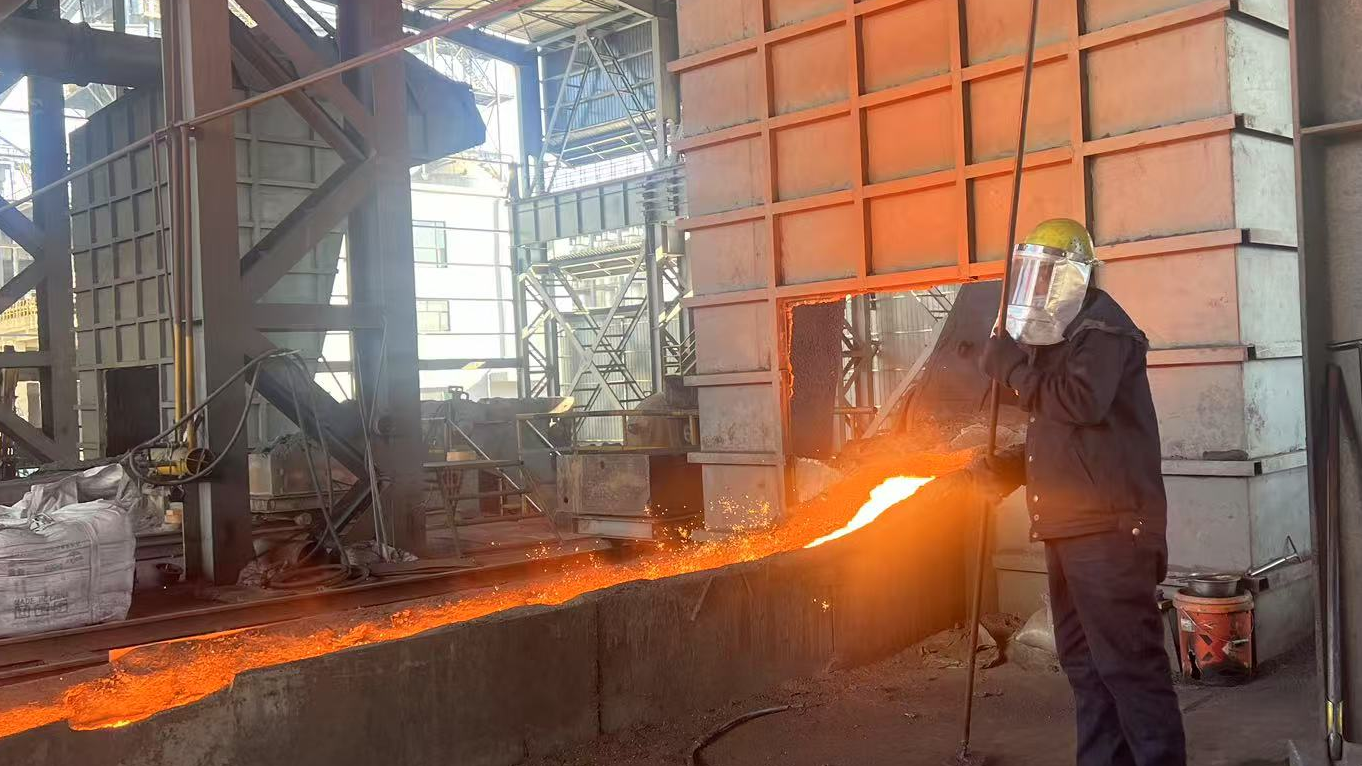Comprehensive Analysis of Blast Furnace Pig Iron Production Process and Technical Parameters
2025-04-30 15:02:27 hits:0
1. Overview of Blast Furnace Pig Iron Production
Blast Furnace Pig Iron is an iron-carbon alloy (3-4.5% carbon) produced through physicochemical reactions in a blast furnace, primarily used in steelmaking, casting, and machinery manufacturing. In 2023, global pig iron production reached 1.3 billion tons, with China accounting for 58.7% (National Bureau of Statistics). The production process involves three stages: raw material preparation, blast furnace smelting, and molten iron treatment.

2. Raw Material Specifications and Pretreatment
2.1 Iron Ore
Quality Standards:
Parameter Steelmaking Pig Iron Casting Pig Iron TFe (Total Iron) ≥62% ≥58% SiO₂ ≤6% ≤8% S ≤0.05% ≤0.06% P ≤0.10% ≤0.12% Explanation: High-grade ore (TFe ≥62%) is directly used for steelmaking pig iron. Casting-grade ore allows slightly lower TFe but requires stricter control of sulfur and phosphorus to prevent brittleness. For example, sulfur exceeding 0.06% causes hot cracks in castings.
Pretreatment Processes:
Sintering: Iron ore fines (<8mm) are mixed with flux (limestone, dolomite) and heated to 1200-1300°C to produce porous sinter (tumbler strength ≥70%). Sinter improves gas permeability in the furnace.
Pelletizing: Concentrates (TFe >64%) are pelletized and roasted at 1250-1350°C to achieve compressive strength ≥2500N/pellet. Pellets ensure uniform burden distribution.
2.2 Coke
Key Specifications:
Parameter Requirement Testing Standard Fixed Carbon (FC) ≥85% GB/T 1997 Sulfur (S) ≤0.70% ISO 351 Coke Strength after Reaction (CSR) ≥65% ISO 18894 Explanation: Coke serves dual roles:
Fuel: Generates heat to maintain furnace temperatures (1200-1500°C).
Reductant: Reacts with iron oxides to produce CO for reduction. Low CSR causes coke fragmentation, disrupting gas flow.
2.3 Flux
Limestone (CaCO₃): 20-50mm grain size, CaO ≥52%. Decomposes into CaO at high temperatures, reacting with SiO₂ to form slag (CaSiO₃) that absorbs impurities.
Dolomite (CaMg(CO₃)₂): MgO ≥18%. Adjusts slag basicity (CaO/SiO₂ ratio) and lowers slag melting point.
3. Blast Furnace Process Parameters
3.1 Burden Structure
| Material | Ratio (%) | Grain Size (mm) |
|---|---|---|
| Sinter | 55-70 | 5-50 |
| Pellets | 15-30 | 8-16 |
| Lump Ore | 10-20 | 10-25 |
| Coke | 25-35% (Layer Ratio) | 25-75 |
Explanation:
Sinter Dominance: 55-70% sinter ensures stable gas permeability.
Layered Coke: Maintains continuous combustion and reduction.
3.2 Operational Parameters
Hot Blast Temperature: 1150-1300°C (Kalugin stove). High temperatures accelerate coke combustion.
Oxygen Enrichment: 3-5% (blast air O₂ 23-25%). Reduces nitrogen-induced heat loss.
Top Pressure: 200-250kPa. Improves gas utilization (>50%) by slowing gas flow.
3.3 In-Furnace Reactions
Indirect Reduction Zone (800-1100°C):
3Fe₂O₃ + CO → 2Fe₃O₄ + CO₂ Fe₃O₄ + CO → 3FeO + CO₂ FeO + CO → Fe + CO₂
Note: CO-driven reactions require controlled CO levels (21-23% CO₂ in top gas).
Direct Reduction Zone (>1100°C):
C + CO₂ → 2CO FeO + C → Fe + CO
Note: Solid carbon reactions are energy-intensive. Maintain direct reduction degree (Rd) at 25-30% to limit fuel ratio (<520kg/t).
4. Quality Control System
4.1 Chemical Composition
| Element | Steelmaking Pig Iron | Casting Pig Iron | High-Purity Pig Iron |
|---|---|---|---|
| C | 3.5-4.5% | 3.0-4.0% | 3.2-3.8% |
| Si | 0.3-1.0% | 1.5-3.5% | 0.8-1.5% |
| Mn | ≤0.50% | ≤0.50% | ≤0.30% |
| P | ≤0.10% | ≤0.06% | ≤0.015% |
| S | ≤0.05% | ≤0.04% | ≤0.010% |
Explanation:
Steelmaking Grade: Low Si/S minimizes slag volume in converters.
Casting Grade: Higher Si (1.5-3.5%) improves fluidity for complex castings.
High-Purity Grade: Ultra-low S/P prevents stress fractures in precision components like wind turbine shafts.
4.2 Testing Methods
Spectrometry: ARL 3460 Optical Emission Spectrometer (±0.005% accuracy).
Thermal Analysis: LECO CS844 Analyzer detects C/S down to 0.001%.
4.3 Defect Mitigation
| Issue | Root Cause | Solution |
|---|---|---|
| High Si | Excessive furnace temperature | Reduce blast temperature by 50-100°C |
| High S | Low slag basicity | Increase CaO/SiO₂ to 1.10-1.15 |
| Low Molten Iron Temp. | Poor coke quality | Use coke with CSR ≥68% |
5. Equipment and Innovations
5.1 Key Equipment
| Equipment | Specification | Manufacturer |
|---|---|---|
| Blast Furnace | 3800m³ volume, 10,000 t/day | MCC Capital Engineering |
| Bell-less Top Charging System | ±2% distribution accuracy | Paul Wurth |
| Ring Slag Scrubber | Dust <5mg/m³ | Danieli |
Explanation:
Bell-less Top: Rotating chute ensures uniform burden distribution, preventing wall erosion.
Slag Scrubber: High-pressure water sprays capture dust for cleaner gas recovery (heat value: 3000-3500kJ/m³).
5.2 Smart Control Systems
Expert System: Baosteel’s BF-Expert reduces fuel ratio by 8kg/t using 30,000 historical datasets.
Digital Twin: ANSYS Twin Builder predicts molten iron temperature (±3°C error) for process optimization.
6. Environmental Compliance and Recycling
6.1 Emission Standards
| Pollutant | National Standard (GB 28663) | Typical Value |
|---|---|---|
| Particulates | ≤15mg/m³ | 8-12mg/m³ |
| SO₂ | ≤100mg/m³ | 50-80mg/m³ |
| NOx | ≤300mg/m³ | 150-250mg/m³ |
6.2 Byproduct Utilization
Slag Applications:
Granulated Blast Furnace Slag (GBFS): Replaces 30-50% cement in concrete, increasing strength by 20%.
Glass-Ceramics: Slag + silica sand melted into corrosion-resistant materials (compressive strength ≥200MPa).
Gas Recovery: Purified gas generates 200-250kWh per ton of pig iron, covering 30% of furnace power needs.

 en
en  fra
fra  de
de  ru
ru  ara
ara  gle
gle  it
it  jp
jp  kor
kor  th
th  zh
zh 


